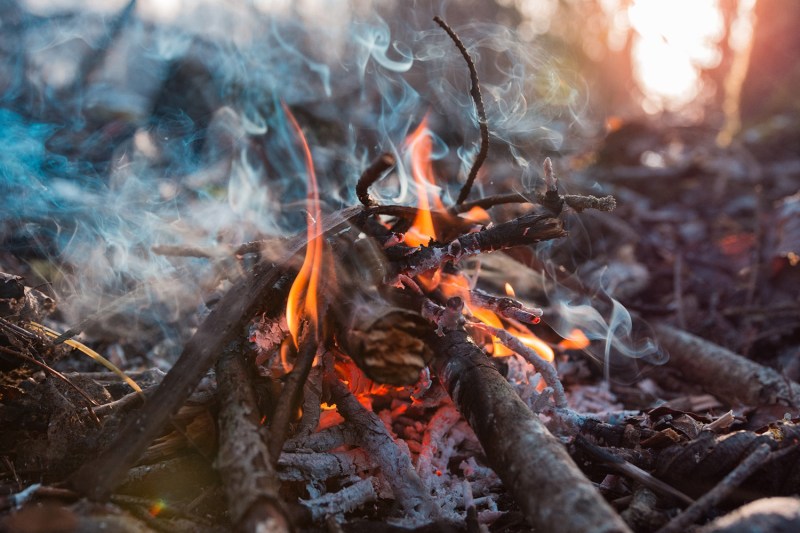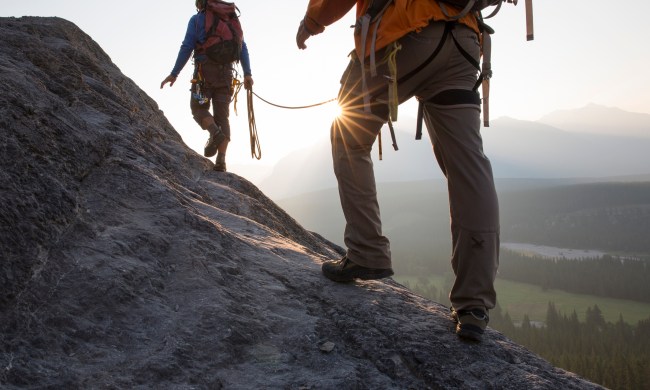Having a campfire is, in my humble opinion, one of the best parts about camping. However, if you’re out in the backcountry, you might not have a fire pit readily available for warmth, light, or cooking. Before you even consider building a fire pit, consult your local authorities. Campfires are a bad idea during the dry season, and many places have fire bans during that time to mitigate the risk of wildfires. You might also need to consider specific regulations or special permits depending on the area. If everything checks out, by all means, get to it! Here’s how to build a campfire pit, as well as how to comply with Leave No Trace principles while you’re at it.
How to build a campfire pit

Choose a safe location
The first step to building a campfire pit is to choose a safe location. Ideally, you’ll want a place that is naturally durable, like a rocky area without vegetation. Keep it at least ten to fifteen feet away from tents, tarps, camping gear, grass, shrubs, or overhanging branches. The area should be relatively flat to keep the campfire from shifting or spreading unexpectedly. It’s also important to pick a location sheltered from strong winds so the sparks don’t fly far. Lastly, it should be in a location that doesn’t interfere with foot traffic or campsite activities. Personally, I also like to have a water source nearby so it’s easy to put everything out.
Prepare the ground
Next, you’ll want to prepare the ground. Remove all dry leaves, twigs, pine needles, and other flammable materials at least a five-foot radius from the campfire pit. Clearing it all down to the bare sand, rock, or gravel will create a buffer zone to prevent the fire from spreading. It’s helpful to keep a trowel in hand to make sure that there are no hidden roots or peat that could burn. The last thing you want is to create an underground fire. The good news is that if you plan to answer nature’s call responsibly while in the woods, you probably already have a trowel on you, so you won’t need to bring additional tools for this.
Don’t gather rocks
While it’s often common practice to gather rocks to form a ring around your campfire, the USDA actually warns against it. Instead, they recommend building a mound fire, which can be done by laying a fire-resistant cloth on the flat, durable area you cleared, and then flattening about two inches of sand, dirt, or gravel on top. Make sure that this layer doesn’t have a lot of organic material. Then, build your fire on top.
If you have to gather rocks. . .
Doing a mound fire is one of the least environmentally damaging ways to have a camp fire, but if you’re in a pinch, a rock ring can keep the area safe. You can’t exactly call it leaving no trace, since there will be evidence of your stay, like ashes or black marks. Choose some rocks that are large enough to form a stable barrier around your campfire, but small enough to carry and arrange easily. These rocks will help shield your fire from the wind or even catch stray sparks before they get too far. For a two-foot diameter pit, around twelve rocks is usually good. However, you don’t want to choose just any kind of rock. Some will explode when heated, so to avoid any surprises, avoid anything that is porous or shows signs of dampness.
That means no rocks found near a river or similar water source, but it could also mean rocks found in a damp area. After you’ve found some suitable candidates of the same size and shape, inspect them for cracks and discard them if they show any signs of fragility. If there are no rocks in the area, use that trowel to dig an actual pit for your fire, and use the extra dirt to build up the sides.
Now it’s time to finally create your ring. First, dig your pit about six inches deep for more sandy or gravelly soil. Use the extra dirt to help build up the sides. If possible, add a layer of sand or gravel to the bottom to reduce heat transfer to the soil. If your soil is more rocky, which makes digging difficult, you can opt for a shallower pit if you have a higher rock barrier.
The smaller your fire pit, the better. A smaller fire is easier to manage than a larger one, so keep it small to minimize environmental impact. Then, arrange your stones in a tight circle around the top.
How to comply with Leave No Trace principles

Building a fire pit while out in the wilderness certainly enhances the outdoor experience, but consider how you are leaving the area before you pack out. Leave No Trace principles are a huge part of wildlife conservation, and it all hinges on restoring your campsite to exactly how it was before to minimize your environmental impact. Of course, as USDA Forest Service puts it, the best way to minimize the effect is not to have a campfire at all, or to use a mound fire, portable stove, or a fire pan if you absolutely can’t do without.
To make sure that your campfire doesn’t encroach on the ecosystem, avoid disturbing pristine areas. Don’t take rocks from areas where they might be supporting natural or cultural sites, and when you’re done, scatter the ashes and fill in your pit. Always follow fire safety protocols, and have fun with those camping recipes.




